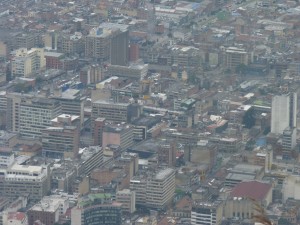Over the years, we’ve heard the same misconceptions from overseas companies about Latin America again and again. Let’s focus on eight of those myths and reveal the real Latin America.
1- They all speak Spanish
Not quite. It’s Portuguese in Brazil. And rightly so, Brazilians are very proud of their language, so English will take you only so far. Spanish won’t take you very far at all – unless you can manage a decent level of Portuñol!
2- They all speak English
Don’t assume you can carry out business relying on English alone. English might be widely spoken by young, university-educated, well-travelled city dwellers, but Spanish and/or Portuguese are key for doing business and building relationships. You can get by using English in many situations, but it’s important to have some flexibility.
3- They all deal in USD
The US dollar is the official currency of some Latin American countries, like Ecuador and Panama. In other countries, most businesses, but not all, are used to dealing in USD, and each country has its own currency. Many businesses are not used to dealing in GBP; it is seen as an “expensive” currency, so people tend to be reticent about it.
4- It’s very hot in Latin America
For a continent that stretches from Mexico down to almost the South Pole, that’s a bit of a generalisation, but it’s amazing how many people wrongly think that all Latin American countries are sunny and hot.
Forget the sunny beach stereotypes – think of the south of Argentina and Chile, for example, and their wonderful skiing resorts and stunning glaciers… So don’t rule out Latin America for those products or services you usually associate with colder climates.
Also, remember that altitude plays a huge part in climate variations, not just the proximity to the equator. As I write this blog post, I am in Quito, right on the equator but also nearly 3000m up the Andes. It’s not particularly hot here, and the temperatures can go down to 7 degrees. Where I live, in Uruguay, we get a cold winter with temperatures going down to zero and below. Yes, it’s not the minus 40 you get in Canada or Poland, but that all-year-round beach weather only exists in some parts of Latin America.

Flying over the (cold and snowy) Andes
5- Latin America is all the same
For a vast continent, Latin America is indeed probably a lot more homogeneous than tiny Europe. Don’t assume it’s “all the same”, though. The continent is incredibly varied. Even within the same country, business codes vary, as well as consumer preferences (as along with accents, architecture, dishes and so on). We discuss this in greater deal in our e-book, and throughout this blog.

River Plate (Uruguay)

Santo Domingo, Ecuador

Bogotá, Colombia.
6- Latin America is poor
I remember visiting a nursery trade show in London a few years ago, where one of the exhibitors thought that no-one in Latin America could possibly afford to buy his product because, in his opinion, Latin America was poor, undeveloped, and we all lived in favelas. His product cost £10. I walked away.

D&G, Bogotá, Colombia
Latin American countries are all developing countries and the spectrum of development and wealth is huge. GDP per capita varies a lot across countries but also within countries and within neighbourhoods, so take broad figures with a pinch of salt.
There is a lot of poverty in Latin America, and right now a lot is being done to fight it. There are significant levels of inequality, varying across and within countries, and there are millionaires and very (very) well-off people across the whole of Latin America – the ones that will pay for a Louis Vuitton bag in Sao Paulo for four times its price in Paris, or the ones that will not blink an eye at buying a brand new Porsche. But the middle class is also growing, so expect your Starbucks, as well as your global mid-segment brands like Gap, to be very popular. Walking into a shopping centre in Santiago de Chile, you will find Accessorize, Whittards of Chelsea, Lush, Clarks and other well-known brands. We also wrote a blog post recently about shopping for luxury goods in Colombia.
And it’s not just about consumer brands. There is a lot of cash in Latin America for infrastructure, energy, mining and manufacturing projects, too. Growth has often come with a development focus and with strong investment.
7- Import duties in Latin America are huge
I hear this again and again, often fuelled by businesses’ experience in Brazil and/or Argentina (the two Latin American giants, along with Mexico). Again, the key here is to remember how big and varied Latin America is. Each country has its own legal and tax system – and its own politicians. Some have favoured leaving their economies open; Mexico, for example, has free trade agreements with nearly every country on earth (the same applies to Chile).
Yes, import duties can be pretty massive in Argentina and Brazil (Mercosur countries), and can be growing and unstable in countries like Ecuador and Venezuela. But many countries have signed free trade agreements with the EU and other trading blocs. Make the most of them.
8- Latin America is fairly compact
One thing about Latin America that always surprises Europeans is how vast it is. To get to Quito (Ecuador), where I’m writing this, from Montevideo (Uruguay), took me 8 hours and 1 stopover (in Lima). Flying to Mexico City from Buenos Aires takes about 12 hours.
The other problem is that flights are often irregular and expensive. No easyjet here, sorry. And very few trains. Road transport is improving but is still generally poor, slow, and unsafe. Remember you have deserts, mountains and huge forests to cross. These natural obstacles (and some human ones, too) make flying the preferred means of transport for business travellers. Book in advance – flights can be hugely expensive and they get overbooked easily. Having said that, Latin American airlines can be quite impressive (my favourite being LAN/TAM and Avianca).
We hope we managed to debunk some of the most popular myths about doing business with Latin America. You can read more in our ebook [link], or by signing up to our monthly newsletter, for the latest news.
Have you heard any other myths about Latin America? Anything you want to double-check about this continent? Leave us your comments and questions below and we’ll do our best to dispel your doubts!

Brilliant summary!!!
Would it be ok if we used this blog in our Portuguese and Spanish for Business classes ?
Best regards: Carla
Surely, Carla, it would be a pleasure and a honour. We have a few blog posts on language/cultural issues in Latin America. There’s a drop-down menu to search by topic. Enjoy!